自考国际商务英语lesson6
国际商务英语综合教程(第三版) Chapter 6
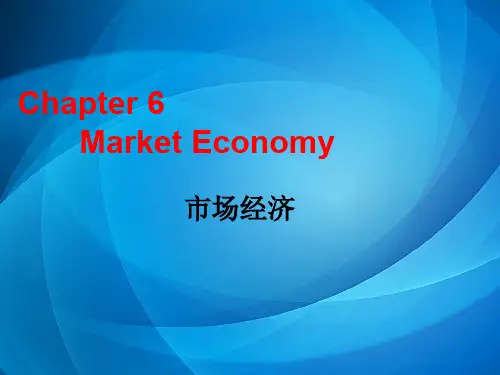
1. A market economy is an economic system in which prices determine how resources will be used and how products will be distributed. 市场经济是一种经济体制,在这种体制中价格决定如何 使用资源和如何分配产品。 1)In which 引导的定语从句修饰主句的表语economic system.译为“在这种经济体制中,价格决定……” 2)how resources will be used and how products will be distributed.两个how 引导的宾语从句作定语从句谓 语动词determine的宾语,译为“价格决定如何使用资 源和如何分配产品。”
5) What is price and its influence?
Price is the quantity of money or other products paid in exchange for something else. Therefore, the current price of something influences how much of it is produced and how much of it is consumed.
在商业中只有当有人既想得到某种商品或服务同时具有买下它的购买力时才会存在对于这种商品或服务的需求
Chapter 6 Market Economy
工商英语课程讲义Unit6(new).
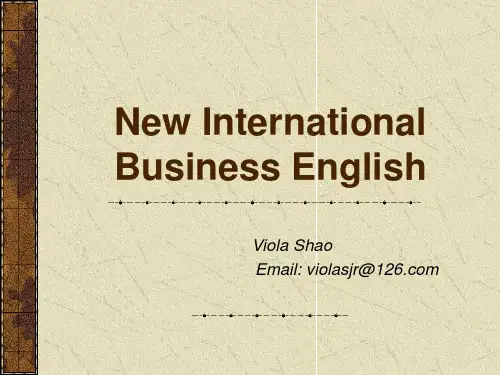
Work B: Expressions (P.53)
Asking for more info:
Could you tell me some more about …? I’d like some more information about …? I’d also like to know … When/ How much/ Why exactly …? There’s something else I’d like to know … Can you give me some more details about …?
Work A (2): Outline for a letter answering an enquiry.
Thank the customer for their interest in your product(s) and confirm that you can (or can’t) help. ‘Sell’ your product and explain how it is suitable for your customer’s needs. Say that you’re sending a catalogue, price list, advertising literature, etc. Explain how the customer can get ‘hands-on’ experience of the product. a. Offer to send samples or get a rep to visit with samples/ demo; b. State the location of distributor’s showroom near enquirer’s address; c. Announce an exhibit at a forthcoming trade fair.
自考国际商务英语lesson5、6
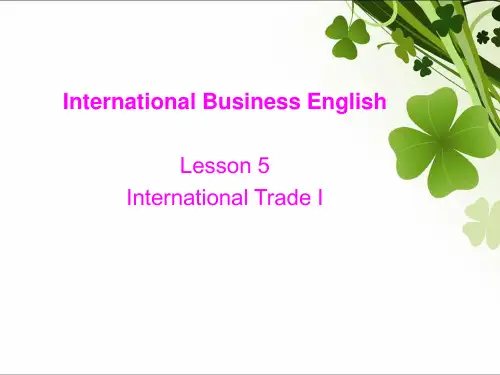
• parative advantage 比较利益: It holds that even if a country is less efficient than another in the production of both commodities, i.e. it has absolute disadvantage in production both commodities, there is still a basis for mutually beneficial trade.
• 4. Export duties 出口关税: Taxes levied on goods leaving an area
• 5. Ad valorem duty 从价税:
• 6. Specific duty 从量税 • 7. Compound duties 复税、混合关税 • 8. Drawback 退税: Duties paid on imported goods
• The kinds of trade nations engage in are varied and complex, often a mixture of visible and invisible trade.
• In the complex economic world, no country can be completely self-sufficient.
• With the development of manufacturing and technology, there arose another incentive for trade, i.e. international specialization.
大学自考英语UnitSixPPT
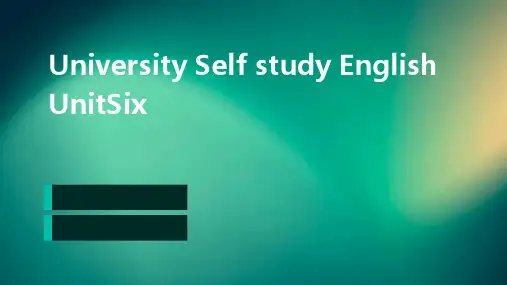
Analysis of listening material types
Lectures and presentations
Familiarize students with the structure and language used in academic lectures and presentations
reasoning, and examples
Reading Skills and Strategies
Skimming
Quickly scanning the text to get a general idea of the main points and topics covered
Scanning
• Critical thinking questions: These challenge your ability to analyze and evaluate the text critically They may ask you to assess the author's credibility, evaluate the effectiveness of the arguments presented, or discuss potential biases or limitations in the text
Narrative
Tells a story, usually in chronological order, with characters, settings, plot, and climax
03
Argumentative
Make a claim or argument and supports it with evidence,
秘书英语Unit6 When are you leaving for the business ev
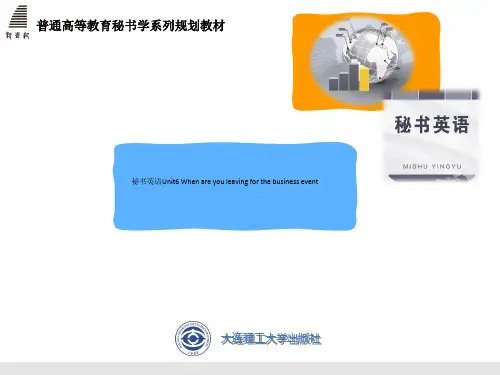
Exporters by Commerce Arrange for the executive to be met at the foreign airport or for a car to
6.1 Sprsking Module
Task Two Pair Work
A: Please don’t worry about it. We’ll try our best. I think Grand Hotel is a nice option. It is within walking distance to the fair. You don’t have to take any taxi, shuttle bus or other vehicles. B: It is very considerate of you to do so. A: That’s all right. What projects should we discuss this time? B: We’d like to talk about your newly-developed decoration materials, especially Model XP. Please bring all the related samples if possible. A: Sure. Anything else? B: We’ll bring some samples of our kitchenware and bathroom appliances. We hope the cooperation between us will be expanded step by step. A: I’m glad to hear that. I’ll call you again when the reservation is made. B: Thank you for calling. Bye! A: Thank you. Bye!
商务英语阅读教案lesson

商务英语阅读教案Lesson 1-5一、Lesson 1: Introduction to Business English ReadingObjective:To introduce students to the importance of business English reading and develop their basic skills for understanding and analyzing business texts. Materials:Textbook: Business English ReadingHandouts: Sample business textsProcedure:1. Expln the importance of business English reading in the global business environment.2. Skills development: Practice reading and prehension skills using sample business texts.3. Group discussion: Students work in groups to analyze and discuss the mn ideas and detls of the texts.4. Summary: Review the key points of the lesson and answer any questions from the students.二、Lesson 2: Understanding Business DocumentsObjective:To help students develop the skills necessary for understanding and analyzing different types of business documents.Materials:Textbook: Business English ReadingHandouts: Sample business documents (e.g., memos, letters, reports) Procedure:1. Expln the purpose of business documents and their importance in business munication.2. Skills development: Practice reading and prehension skills using sample business documents.3. Group activity: Students work in groups to identify and analyze the mn ponents of the business documents.4. Summary: Review the key points of the lesson and answer any questions from the students.三、Lesson 3: Analyzing Business NewsObjective:To help students develop the skills necessary for understanding and analyzing business news articles.Materials:Textbook: Business English ReadingHandouts: Sample business news articlesProcedure:1. Expln the importance of business news in the global business environment.2. Skills development: Practice reading and prehension skills usingsample business news articles.3. Group discussion: Students work in groups to analyze and discuss the mn ideas and detls of the articles.4. Summary: Review the key points of the lesson and answer any questions from the students.四、Lesson 4: Reading Business ReportsObjective:To help students develop the skills necessary for understanding and analyzing business reports.Materials:Textbook: Business English ReadingHandouts: Sample business reportsProcedure:1. Expln the purpose of business reports and their importance in decision-making processes.2. Skills development: Practice reading and prehension skills using sample business reports.3. Group activity: Students work in groups to identify and analyze the mn sections and findings of the reports.4. Summary: Review the key points of the lesson and answer any questions from the students.五、Lesson 5: Enhancing Reading Comprehension StrategiesObjective:To help students develop effective reading prehension strategies for better understanding business texts.Materials:Textbook: Business English ReadingHandouts: Sample business texts with acpanying prehension questions Procedure:1. Discuss the importance of using prehension strategies while reading business texts.2. Skills development: Practice using various prehension strategies (e.g., predicting, skimming, scanning) while reading sample business texts.3. Group activity: Students work in groups to answer prehension questions based on the texts they have read.4. Summary: Review the key points of the lesson and answer any questions from the students.六、Lesson 6: Interpreting Business StatisticsObjective:To help students develop the skills necessary for interpreting business statistics and data presented in various formats.Materials:Textbook: Business English ReadingHandouts: Sample business texts with statistics and data tablesProcedure:1. Expln the importance of interpreting business statistics in decision-making processes.2. Skills development: Practice interpreting business statistics and data using sample texts and tables.3. Group activity: Students work in groups to analyze and interpret the statistics and data presented in the texts and tables.4. Summary: Review the key points of the lesson and answer any questions from the students.七、Lesson 7: Understanding Financial StatementsObjective:To help students develop the skills necessary for understanding and analyzing financial statements.Materials:Textbook: Business English ReadingHandouts: Sample financial statements (e.g., balance sheets, ine statements, cash flow statements)Procedure:1. Expln the purpose and importance of financial statements in business.2. Skills development: Practice understanding and analyzing financial statements using sample texts and statements.3. Group activity: Students work in groups to analyze and interpret the financial statements provided.4. Summary: Review the key points of the lesson and answer any questions from the students.八、Lesson 8: Reading Case StudiesObjective:To help students develop the skills necessary for understanding and analyzing business case studies.Materials:Textbook: Business English ReadingHandouts: Sample business case studiesProcedure:1. Expln the purpose of business case studies and their importance in learning about real-world business situations.2. Skills development: Practice reading and prehension skills using sample business case studies.3. Group discussion: Students work in groups to analyze and discuss the mn issues and solutions presented in the case studies.4. Summary: Review the key points of the lesson and answer any questions from the students.九、Lesson 9: Writing Summaries for Business TextsObjective:To help students develop the skills necessary for writing effective summaries of business texts.Materials:Textbook: Business English ReadingHandouts: Sample business texts and summary guidelines Procedure:1. Expln the importance of writing summaries for business texts and their usefulness in munication and decision-making.2. Skills development: Practice writing summaries of sample business texts using provided guidelines.3. Group activity: Students work in groups to write summaries of the texts they have read, and then exchange and discuss their summaries.4. Summary: Review the key points of the lesson, provide feedback on the students' summaries, and answer any questions from the students.十、Lesson 10: Evaluating Business Information SourcesObjective:To help students develop the skills necessary for evaluating the credibility and reliability of business information sources.Materials:Textbook: Business English ReadingHandouts: Sample business information sources (e.g., articles, websites, reports)Procedure:1. Expln the importance of evaluating business information sources and the potential risks of using unreliable information.2. Skills development: Practice evaluating the credibility and reliability of sample business information sources.3. Group activity: Students work in groups to evaluate the provided business information sources and identify their strengths and weaknesses.4. Summary: Review the key points of the lesson, discuss the students' evaluations, and answer any questions from the students.重点和难点解析一、Lesson 1: Introduction to Business English Reading补充说明:强调商务英语阅读在全球商务环境中的作用,以及如何通过练习阅读和理解商务文本来提高基本技能。
商英第六课
3) nervous anxiety , worry or pressure紧张;焦虑
Eg: nervous tension神经性紧张
4) an anxious, untrusting, and perhaps dangerous condition in the relationship between people, countries, etc.紧张关系,紧张局势
municative Skills: expressions of “ Apologizing”
4.Phonetic Review: plosives
Step 1:Offer some questions around business and require them to have a discussion in group.
Eg: Irish immigrants来自爱尔兰的移民
相关词:immigrate v.immigrate toenter a foreign country in order to live there permanently
Immigration n.移民
Immigration control (对外来)的移民管制pass through immigration通过移民局检查
8.It was very careless of me, I’m afraid.
9.It wouldn’t happen again.
10.We shall ensure that similar mistakes will not occur again.
(2)Diamondis a cleat, very hard and valuable stone, used in jewelry and in industry, for example, a diamond engagement ring. Diamond was discovered in 500 B.C. inIndia.
自考国际商务英语_句子翻译
LESSON 1 INTERNATIONAL BUSINESS国际商务1. 国际贸易一般指不同国家的当事人进行的交易,它涉及到许多因素,因而比国内贸易要复杂得多。
International business refers to transaction between parties from different countries. It involves more factors and thus is more complicated than domestic countries.2. 随着经济一体化进程的发展,很少人和公司能完全独立于国际商务之外而存在。
因此,在此方面具有一定的知识是十分必要的,这既有益于企业的发展又有益于个人的进步。
With the development of economic globalization, few people or companies can completely stay away from international business. Therefore, some knowledge in this respect is necessary both for the benefit of enterprises and personal advancement.3. 其他参与国际贸易的形式有管理合同、承包生产和“交钥匙”工程。
Other forms for participating in international business are management contract, contract manufacturing, and turnkey project.4. 国际贸易最初以商品贸易的形式出现,即在一国生产或制造商品而出口或进口到另一国进行消费或转售。
International business first took the form of commodity trade, i.e. exporting and importing goods produced or manufactured in one country for consumption or resale in another.5. 除了国际贸易和投资,国际许可和特许经营有时也是进入国外市场的一种方式。
国际商务英语Lesson6InternationalTrade(II)PPT教学课件
appealing, especially a choice food.美味佳
肴使人愉悦高兴的,吸引人的东西,尤指食 物
abhorrent:disgusting, loathsome, or
repellent.令人生厌的,令人反感的,引起厌
cargo compartment: 货舱
charter:to hire (a bus or an airplane,
for example) for the exclusive, temporary use of a group of travelers. 包租租(如公共
汽车或飞机)以供一群旅游者短时内独自专 用
duty
2020/12/10
compound duties
drawback most-favored-
nation (MFN) tariff schedule non-tariff
barrier visible trade invisible trade
2
Words and Expressions
Lesson 6 International Trade(II)
2020/12/10
1
Commercial terms
tariff quota customs area customs union import duties export duties specific duty Ad valorem
involving, or affecting only one side:一方的
属于、在、有、包含或影响仅一边的:
2020/12/10
5
maritime:of, relating to, or adjacent
国际商务英语课文电子版lesson (6)
Where there are no differences among countries in the basic capabilities at producing goods, other bases for trade among them may still exist. First, patterns of demand may differ among nations. For example, most consumers in one country may consider dog meat a delicacy(delicious food), while in another country the consumption of dog meat is abhorrent. In this case the second country may sell its dog meat to the first country. Trade will be based not on differences in theproduction capabilities of the two countries but on different consumption preferences.Second, trade may occur out of economies of scale,that is, the cost advantages of large-scale production. For example, Country A and Country B may have the same capability in producing cars and computers, but the cost for the production of both commodities will decrease if the goods are produced on a larger scale. Both countries might find it advantageous if eachwere to specialize completely in the production of one commodity and import the other.Third, trade takes place because of innovation or style.Even though Country A produces enough cars at reasonable costs to meet its own demand and even to export some, it may still import cars from other countries for innovation or variety of style.To summarize, the theory of international specialization seeks to answer the question which countrieswill produce what goods, with what trade patterns among them. Differences in production conditions, the element highlighted (stressed) by the theory of comparative advantage, provide the most important part of the answer. But a complete answer must also take into account other factors such as patterns of demand, economies of scale and innovation or style.In reality, however, complete specialization may never occur even when it is economicallyadvantageous. For strategic or domestic reasons, a country may continue to produce goods for which it does not have an advantage. The benefits of specialization may also be affected by transport cost. Goods and raw materials have to be transported around the world and the cost of the transport reduces the benefit of trade. The case will be more serious with transporting bulky or perishable goods. Protectionist measures which are often taken by governments are also barriers totrade, and typical examples are tariffs and quotas.Tariff barriers are the most common form of trade restriction. A tariff is a tax levied on a commodity when it crosses the boundary of a customs area which usually coincides with the area of a country.A customs area extending beyond national boundaries to include two or more independent nations is called a customs union. Import duties are tariffs levied on goods entering an (customs) area while export dutiesare taxes levied on goods leaving an (customs) area. The former type is more common than the latter as most nations want to expand exports and increase their foreign exchange earnings (income). Import duties may be either specific, or ad valorem, or a combination of the two –compound duties. The term drawback refers to duties paid on imported goods that are refunded if the goods are reexported. The term most-favored-nation (MFN) treatment refers to a tariff treatment.Under this treatment, a country is required to extend to all signatories (contracting parties) any tariff concessions(关税减让) granted (given) to any participating country. However, MFN treatment is not really special but is just normal trading status. It gives a country the lowest tariffs only within the tariff’s schedule, but it is still possible to have lower tariffs.Quotas or quantitative (quantity) restrictions are the most common form of non-tariff barriers. A quotalimits the imports or exports of a commodity during a given period of time. The limits may be in quantity or value terms, and quotas may be on a country basis or global, without reference to countries. They may be imposed unilaterally and can also be negotiated on a so-called voluntary basis. Obviously, exporting countries do not readily agree to limit their sales. Thus, the “voluntary” label generally means that the importing country has threatened to imposeeven worse restrictions if voluntary cooperation is not forthcoming.In addition to visible trade, which involves the import and export of goods, there is also invisible trade, which involves the exchange of services between countries.Transportation service across national boundaries is an important kind of invisible trade. International transportation involves different means of transport such as ocean ships, planes, trains, trucks andinland water vessels. However, the most important of them is maritime ships. When an exporter arranges shipment, he generally books space in the cargo compartment of a ship, or charter a whole vessel. Some countries such as Greece and Norway have large maritime fleets and earn a lot by way of this invisible trade.Insurance is another important kind of invisible trade. In the course of transportation, a cargo is vulnerable to many risks such ascollision, pilferage, fire, storm, explosion, and even war. Goods being transported in international trade must be insured against loss or damage. Large insurance companies provide service for international trade and earn fees for insuring other nation's foreign trade. Lloyd's of London is a leading exporter of this service.Tourism is yet another important form of invisible trade. Many countries may have beautiful scenery, wonderful attractions,places of historical interest, or merely a mild and sunny climate. These countries attract large numbers of tourists, who spend money for travelling, hotel accommodations, meals, taxis, and so on. Some countries depend heavily on tourism for their foreign exchange earnings, and many countries are making great efforts to develop their tourism.The fourth type of invisible trade meriting (deserving) attention is called immigrant remittance. Thisrefers to the money sent back to home countries by people working in a foreign land. Import and export of labour service may be undertaken by individuals, or organized by companies or even by states. And this is becoming an important kind of invisible trade for some countries.Invisible trade can be as important to some countries as visible trade is to others. In reality, the kinds of trade nations engage in are varied(various) and complex(complicated), often a mixture of visible and invisible trade.。
- 1、下载文档前请自行甄别文档内容的完整性,平台不提供额外的编辑、内容补充、找答案等附加服务。
- 2、"仅部分预览"的文档,不可在线预览部分如存在完整性等问题,可反馈申请退款(可完整预览的文档不适用该条件!)。
- 3、如文档侵犯您的权益,请联系客服反馈,我们会尽快为您处理(人工客服工作时间:9:00-18:30)。
Trade Terms
• • 1. Tariff 关税: A tax levied on a commodity when it crosses the boundary of a custom area. 2. Quota 配额: A quota limits the imports or exports of a commodity during a given period of time. It is the most common form of non-tariff barriers. 3. Import duties 进口关税: Tariffs levied on goods entering an area 4. Export duties 出口关税: Taxes levied on goods leaving an area
(2) The reasons why complete specialization may never occur
(3) Tariff barriers-the most common form of trade restriction A. Export duty B. Import duty a. Specific duty b. Ad valorem duty c. Compound duty (4) Quotas-the most common form of non-tariff barriers
• The kinds of trade nations engage in are varied and complex, often a mixture of visible and invisible trade.
International Business English
Lesson பைடு நூலகம் International Trade II
Business Knowledge
(1) Other bases for trade among countries A. Patterns of demand: different consumption preference B. Economy of scale: the cost advantages of large-scale production C. Innovation or style
• Quotas or quantitative restrictions are the most common form of non-tariff barriers.
• The visible trade is the import and export of goods, and the invisible trade is the exchange of services between countries.
• The cost of a product will decrease with the expansion of production scale.
• In reality, complete specialization may never occur even though it is economically advantageous.
• •
•
5. Ad valorem duty 从价税:
• •
6. Specific duty 从量税 7. Compound duties 复税、混合关税
•
•
8. Drawback 退税: Duties paid on imported goods that are refunded if the goods are reexported.
9. Most-favored-nation (MFN) treatment 最惠国待遇 : A tariff treatment under which a country is required to extend to all signatories any tariff concessions granted to any participating country
10. Tariff schedule 税率表、税则
11. Non-tariff barrier 非关税壁垒
12. GSP 普惠制: Generalized system of preferences. 13. Reasonable costs 合理的成本
14. Customs area 关税区
15. Customs union 关税同盟 16. Tariff barriers 关税壁垒: The traditional protectionism measure
